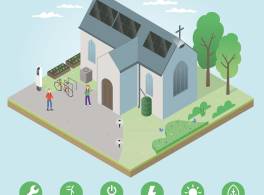Church buildings are often solidly built and, when maintained well, have withstood the weather over the centuries.
However, as the climate changes, and weather events becomes more extreme, they can become vulnerable. We need to be protect these precious buildings from harm.
At the same time, our churches act as sanctuaries for their communities; they are often built on higher ground and more solidly-constructed than the houses around them, so can be a place of safety during a flood, and can act as a cool sanctuary in a heatwave.
Below, you can explore the kinds of changes that could help your church adapt to our changing climate, so that extreme weather events cause less harm and can be recovered from more quickly.
Clicking on diagram below will let you explore the main risks, and potential risk mitigation actions you can take.
The climate resilient church
Guidance
Becoming a Climate Resilient Church may seem initially daunting, but the guidance provided below provides a breakdown of the process that can be undertaken in any church to begin its resilience journey.
Five key steps every church should take to ensure their church building is climate resilient include Good maintenance practices, Identifying and discussing potential risks, Creating a Future Climate Action Plan, Communicating expectations and Undertaking a regular review process.
The guidance produced by the Church Buildings Council goes into depth on how this is best achieved and provides support in creating climate-resilient communities.
Webinars, advice and support
There is a range of advice and support available to help you on your journey towards being a ‘climate resilient church’.
Case studies of climate resilient churches
During 2022, the Cathedral and Church Buildings division received funding from NERC to create a cache of valuable case studies and resources.
Our researcher identified examples from around the country, showing churches creating climate resilient, future-proof buildings and supporting their communities through extreme weather events.
- Responding as an emergency flood centre: When the bottom half of the town flooded in February 2021, Snaith's St Laurence Priory opened their doors to act as a community hub for the emergency response.
- Creating a flood resilient church building: As part of a major re-ordering scheme, Tirley St Michael & All Angels church have introduced an array of flood resilience features.
- St Marys Ellenbrook provides a cool refuge during a hot summer: As a building with a high heat capacity, St Marys Ellenbrook was uniquely placed within the local area to provide a space for people to escape the high temperatures, during the heatwave of July 2022.
- Protecting a church from wildfire: After being affected by a wildfire in 2022, St Mary & St Peters in Wennington learnt how to best protect the land for the future.
- Adjusting to subsidence, as part of a major reordering: Facing the effects of local subsidence, St Edward the Confessors church in Mottingham were forced to intervene, adapting to emerging cracks in the floor.
- Protecting a church from future subsidence | The Church of England: St Johns has had to contend with subsidence for most of its history, and recently took practical action to protect its future.
- Taking early preventative action on damp ingress | The Church of England: This Major Church took early steps to prevent the worsening damp in its historic fabric.
- Adjusting a church building to regular floods | The Church of England: With flooding becoming an accepted reality, St Denys has created proactive plans to mitigate damage.
- Responding to extreme flooding events | The Church of England: Unexpected flooding caused significant problems for St Aidans in Carlisle.
- Recovering from floods alongside the community | The Church of England: Community was put at the heart of this church's flood response, with mutual benefits.
- Providing a refuge against flooding | The Church of England: The elevated position of St Cuthberts afforded it protection from a flood, in turn allowing it to act as a refuge for locals.
- Creating a warm refuge for the community | The Church of England: An existing church hall cafe became a warm community space during a winter when energy bills were on the rise.
This page was created collaboratively with staff and volunteers from the Diocese of Leeds.
We are very grateful to them for their expert input.


